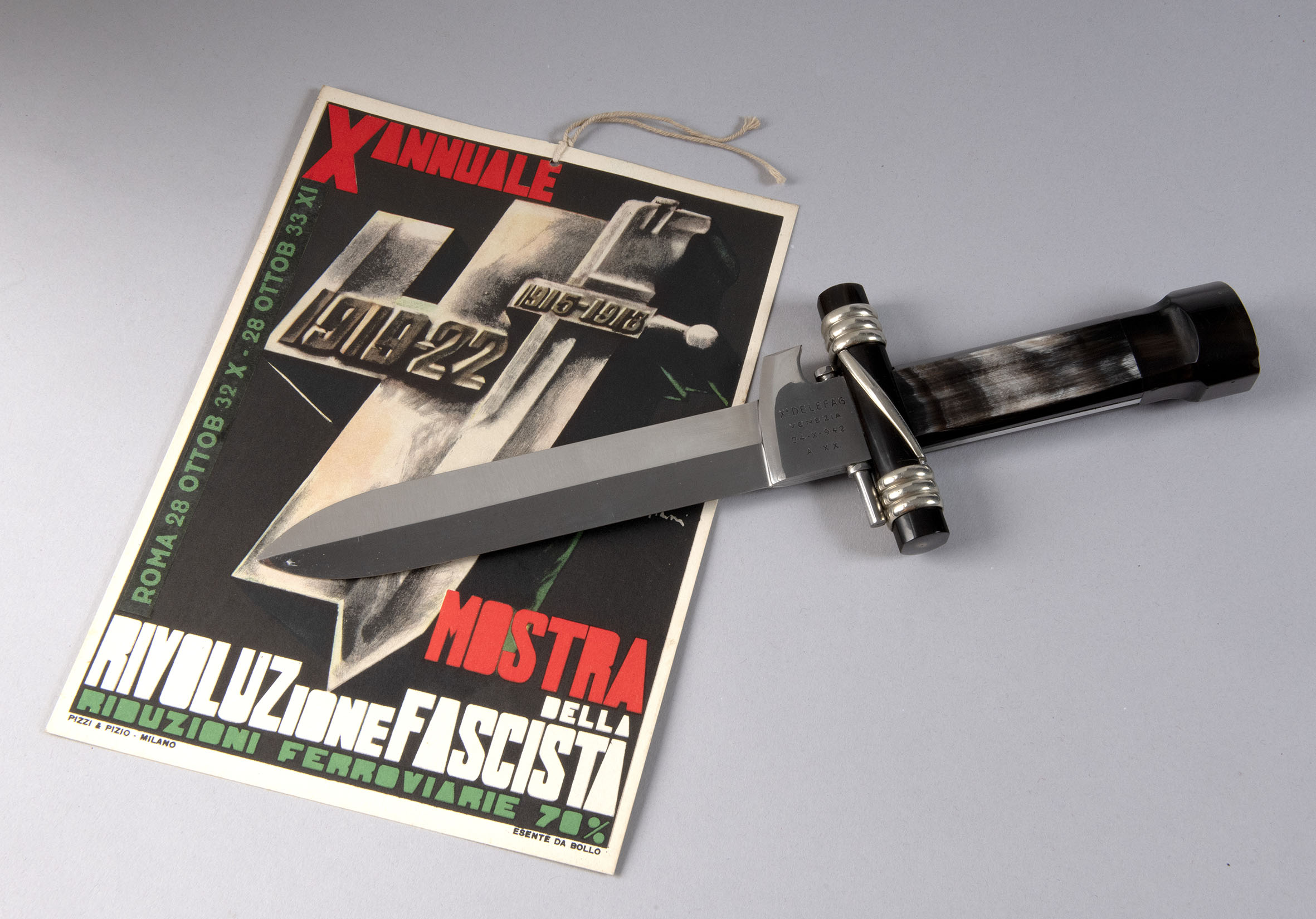Exhibition of the Fascist Revolution – 10th Anniversary
One of several posters promoting the Mostra della Rivoluzione Fascista (Exhibition of the Fascist Revolution), an art exhibition intended to commemorate the revolutionaries who had taken part in the rise to power of Fascism. This example, illustrated by Mario Sironi for the exhibition’s opening on the 10th anniversary of the March on Rome, is characterized by its starkly modern, sharp, aggressive lines.
Sironi was a painter and an early member of the Futurist movement in the years before World War I. After the war, he was one of the founders of the Novecento Italiano movement and declared his support for Mussolini. He contributed hundreds of illustrations and designed covers for the Fascist newspapers Il Popolo d’Italia and La Rivista Illustrata del Popola d’Italia. He also designed pavilions for exhibitions and numerous posters, both political and commercial (including for Fiat). He eventually abandoned easel painting in favor of communicating via “a fusion of decoration and architecture exemplified by Gothic cathedrals.” He felt that the mural was the proper basis of a popular national art.
Unlike Adolf Hitler and the Nazi Party, who openly attacked modern architecture and art on both stylistic and racial grounds, Italian Fascism had been closely linked since its early inception to avant-garde artistic movements such as Futurism. Many of Italy’s most renowned artists and architects were ardent fascists who tried in every possible way to embody fascist values in their work. Italian Fascism, as reflected in its ideological doctrine, was much more open towards new ideas and lacked the artistically counterproductive fixation on stylistic purity and traditionalist realism that defined the Nazi aesthetic and which often times sapped an artwork of its creative vitality.
Free shipping on orders over $50!
- Satisfaction Guaranteed
- No Hassle Refunds
- Secure Payments
One of several posters promoting the Mostra della Rivoluzione Fascista (Exhibition of the Fascist Revolution), an art exhibition intended to commemorate the revolutionaries who had taken part in the rise to power of Fascism. This example, illustrated by Mario Sironi for the exhibition’s opening on the 10th anniversary of the March on Rome, is characterized by its starkly modern, sharp, aggressive lines.
Sironi was a painter and an early member of the Futurist movement in the years before World War I. After the war, he was one of the founders of the Novecento Italiano movement and declared his support for Mussolini. He contributed hundreds of illustrations and designed covers for the Fascist newspapers Il Popolo d’Italia and La Rivista Illustrata del Popola d’Italia. He also designed pavilions for exhibitions and numerous posters, both political and commercial (including for Fiat). He eventually abandoned easel painting in favor of communicating via “a fusion of decoration and architecture exemplified by Gothic cathedrals.” He felt that the mural was the proper basis of a popular national art.
Unlike Adolf Hitler and the Nazi Party, who openly attacked modern architecture and art on both stylistic and racial grounds, Italian Fascism had been closely linked since its early inception to avant-garde artistic movements such as Futurism. Many of Italy’s most renowned artists and architects were ardent fascists who tried in every possible way to embody fascist values in their work. Italian Fascism, as reflected in its ideological doctrine, was much more open towards new ideas and lacked the artistically counterproductive fixation on stylistic purity and traditionalist realism that defined the Nazi aesthetic and which often times sapped an artwork of its creative vitality.






